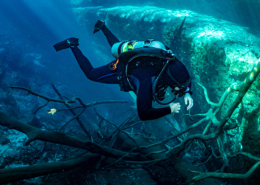For much of the world, winter is upon us. In many places that means temperatures are dropping both in and out of the water and many people are either dusting off their drysuits or hanging up their equipment until temperatures rise again in the spring.
Today’s post is dedicated to those of us who live in regions with milder climates where owning a drysuit is not common or mandatory and are perhaps suffering a bit this time of year. It’s also for those of us who dive multiple times a week and need to ensure they stay warm no matter what. So, without further ado, here’s how to stay warmer while diving in a wetsuit.
Layers are your friend
Just like you might wrap yourself up in a cozy scarf, knit jumper, thick socks, boots, and a wooly hat to prepare yourself to better handle chilly air outside, layering your exposure protection will help you stay warmer in the water as well.
The most useful addition to a properly fitting full length wetsuit is a hooded vest. A hood by itself is helpful (as long as it fits well), but I think a hooded vest is much better since it adds another layer of insulation around your chest and also can help prevent chilly water from leaking in around your wetsuit’s neck seal and back zipper area. If your wetsuit already has a hood attached to it, you can add extra insulation to your core by wearing a 3mm shorty under or over your full wetsuit.
In addition to a hooded vest, I find that some of the assorted thermal products made for layering under your wetsuit can make a big difference in your warmth. For example, a handful of companies manufacture layers that are essentially wooly sweaters made for diving. Initially, I was skeptical about whether something like this would actually help prevent me from feeling like I was becoming a human popsicle. “It’s just a fancy overpriced rash guard with some fuzzy stuff in it!” I remember thinking. But let me tell you…the one I purchased made a HUGE difference and is now a MUST for me during almost every dive.
In a pinch, I have been able to wear a tight fitting wool sweater from the thrift store as an extra layer, though it took ages to dry after the dive and I’m certain it would not hold up as a long term solution.
Consider a smaller wetsuit
Sometimes solving the problem is as simple as switching to a better fitting wetsuit. A wetsuit works by trapping a thin layer of water inside and reducing the amount of cool water that passes over your skin. Your body then is able to warm up the trapped water, therefore slowing the speed at which it loses heat.
If your wetsuit is not tight enough, more water will flush through it and your body will lose more heat and need to work harder to stay warm. This is why a properly fitting wetsuit is critical. You want something that will allow the least amount of water possible to pass through it. In some cases this means putting your suit on will not be the most fun part of a day of diving, but the suffering is well worth the warmth you will retain.
Try not to pee in your wetsuit
I’m team pee in your wetsuit, 100%. I’ve previously written extensively about the benefits of peeing in your wetsuit. Unfortunately, staying warm is not one of them.
While urinating in your wetsuit will provide some temporary warmth, it actually makes you worse off in the long run. When you pee in your suit, your body reacts to the warmth by opening up the blood vessels at the surface of your skin (the opposite of what happens when you immerse yourself in cold water), your body basically tricks itself into thinking it is warm again. Shortly after, the warm fluid escapes (or is flushed out) of your wetsuit and is replaced again with cool water. Because your blood vessels are not constricted, you lose a lot of body heat when that cool water comes back into the suit, which is why it is not advised to try and warm yourself up on a cold dive by peeing.
Stay warm BEFORE your dive
You know that you lose heat 20x faster in the water than on land. If you’re cold before you even get into the water you’d better bet you’ll be even colder once you get into the water. So, bundle up before you go diving.
As ridiculous as it sounds, I will go as far as wearing long trousers with leggings under them, two layers of shirts, a scarf, and a jumper to stay warm before a dive…and I live in a warm climate year round. If you’re diving somewhere colder, you’ll want to layer up even more before your dive and try to change into your suit somewhere warm as well.
Food is your friend
Make sure you eat a nice healthy meal before you go diving. This will not only help ensure you have enough energy throughout the dive, but also it will help you stay warm because as your body works to digest food, it generates heat. If you’re the type to get seasick easily or tend to have any digestive issues if you eat before a dive, consider giving this tip a pass.
The best foods to eat before diving are those that are high in protein and (ideally) healthy fats. My favorite pre-dive stay-warm food: breakfast tacos (de papas con chorizo por favor).
Properly warm up between dives
As I mentioned before, if you’re cold before you even start a dive, you’ll be super cold during the dive. So, don’t start a dive unless you’re properly warmed up. Sometimes the problem will solve itself by simply staying out of the water for a little bit or as you go through the motions of preparing for a second dive, especially if you’re shore diving and have a little hike to the dive site. Other times, you’ll need to take some steps to warm yourself up.
Ways you can warm up between dives vary by circumstances. If you can, consider wrapping up in a nice cozy jacket. When I dive in California, I always like to have my old water polo parka from high school to keep me warm after a dive. Maybe eat a small warm snack and/or sip on a hot cocoa between dives. I know some people who bring thermoses of hot water with them to pour down their suits between dives. Find a way to warm up that works for you and stick with it; do NOT go into the water again until you are properly warmed up.
…Know when to throw in the towel
I cannot stress enough how important it is to listen to your body. There is no shame in calling a dive. Period. You need to be prepared to call the dive before you are too cold to comfortably and safely continue.
In some situations the need to call a dive due to temperature will be more obvious than others. For example, if you’re clearly at risk of developing hypothermia or are shivering. In other cases, the need to call a dive may feel less urgent. For example, if the water itself is not particularly cold, but it’s chilly enough to feel a bit uncomfortable. In these situations it is critical that you recognize when you need to call the dive. If you’re cold enough to be conscious of it, you’re cold enough to be distracted. Better to call the dive and warm up before being a little cold causes a big problem.
Finally, if it seems that you’re getting cold no matter what you try, it may be time to try diving dry. The important thing to know is that you do not HAVE to be cold, and you certainly do not have to give up diving when the temperatures drop a bit. You always have options.
A quick disclaimer:
For many places, diving in a wetsuit during this time of the year is simply not an option. By no means am I suggesting anyone use the advice in this post to attempt diving places where a drysuit is warranted in a wetsuit. If you simply cannot stay warm, do not dive.










Laisser un commentaire
Rejoindre la discussion?N’hésitez pas à contribuer !